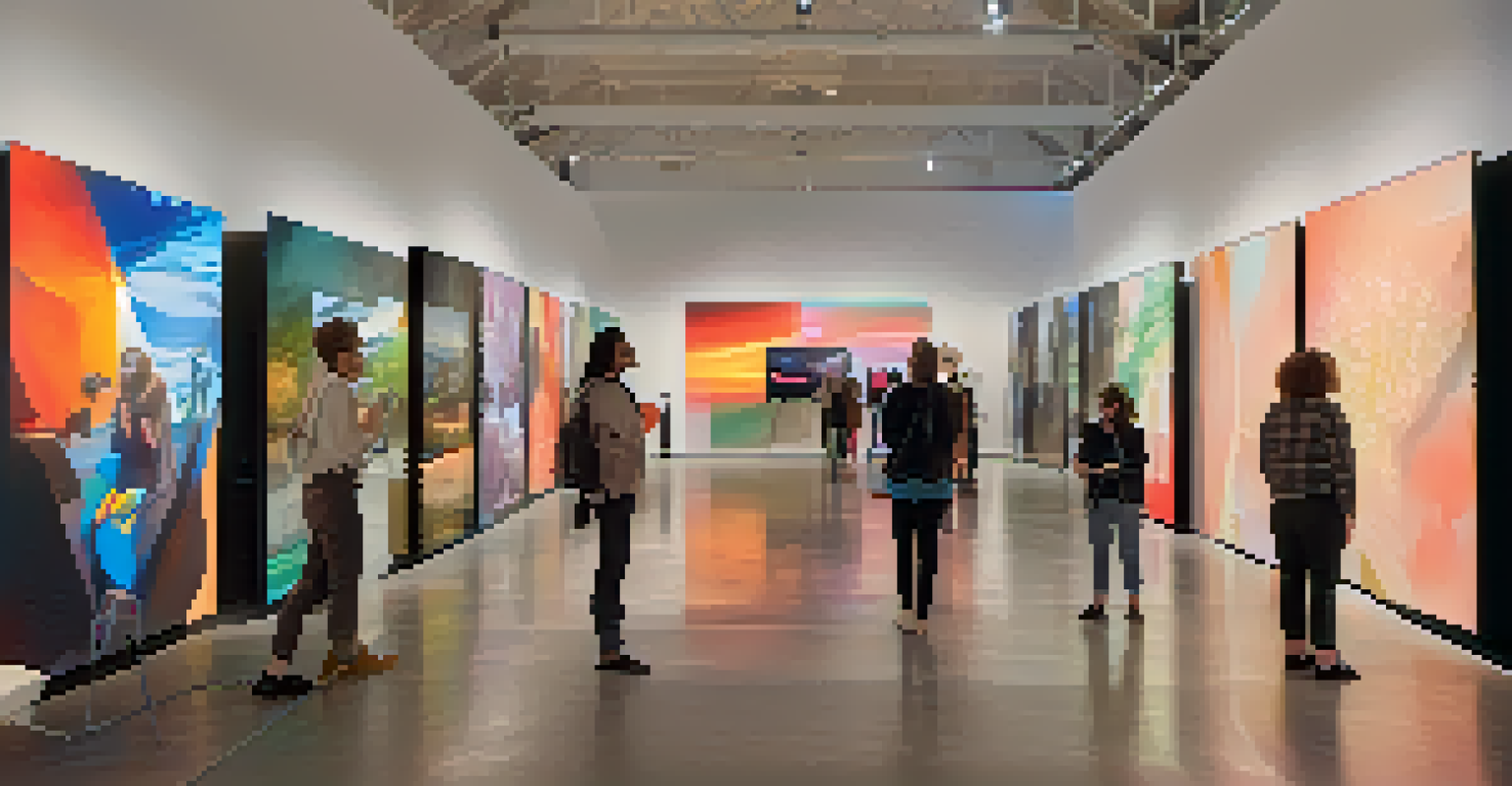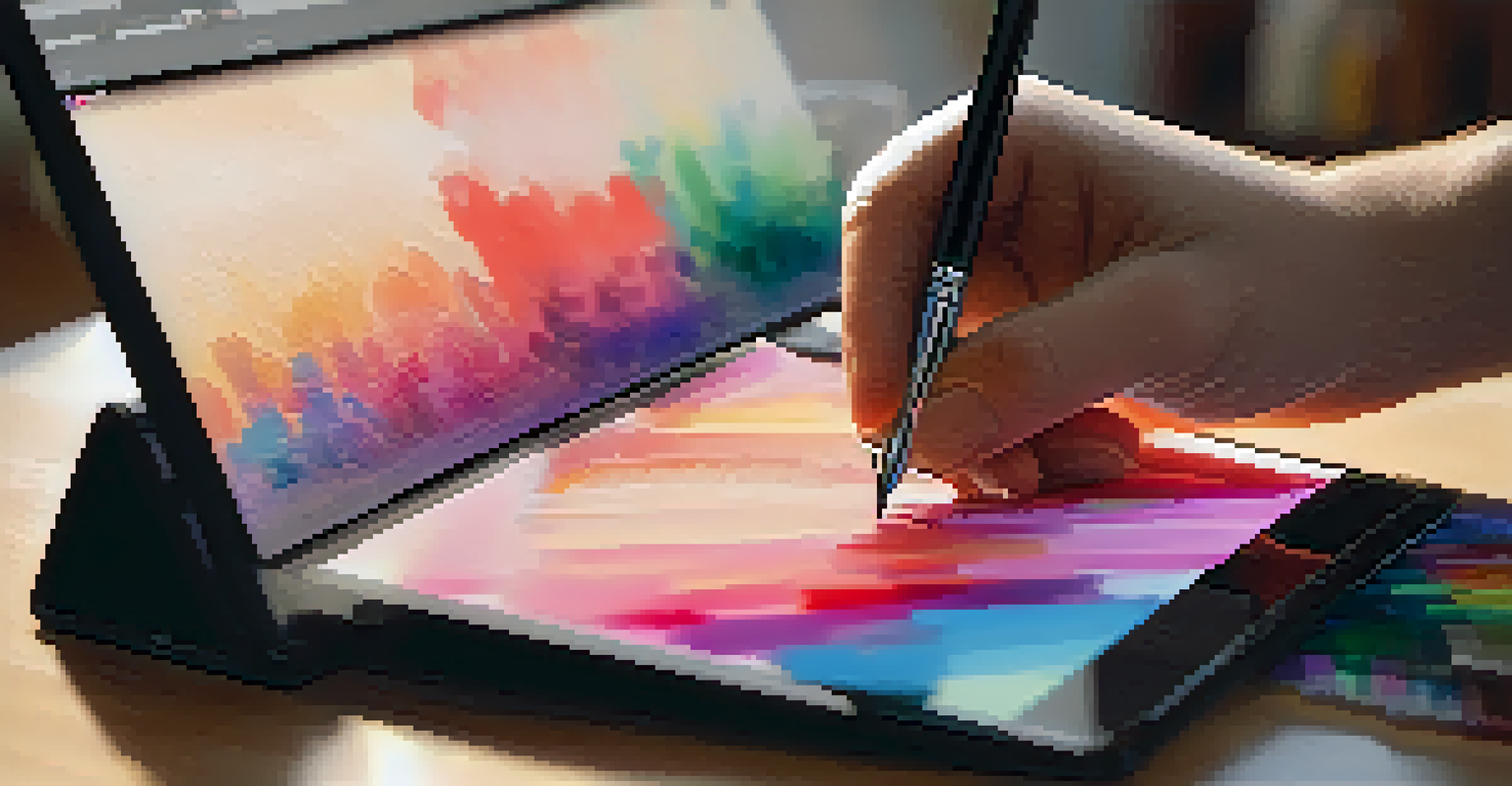The Role of Technology in Global Art Production and Sharing

Technology as a Catalyst for Artistic Innovation
In today's world, technology serves as a powerful catalyst for artistic innovation. Artists are no longer confined to traditional mediums; instead, they can explore digital tools that allow for an explosion of creativity. For instance, software like Adobe Creative Suite enables creators to manipulate images and designs in ways that were unimaginable just a few decades ago.
Art is not freedom from discipline, but disciplined freedom.
Moreover, technologies like 3D printing and virtual reality are pushing the boundaries of what art can be. Artists can create intricate sculptures or immersive environments that invite viewers to engage with their work on a whole new level. This shift not only enhances artistic expression but also invites collaboration across various disciplines.
Ultimately, technology is reshaping how we define art itself. It encourages experimentation and opens doors for diverse voices to be heard, creating a more vibrant artistic community. The question is no longer just what art is, but what it can become through the lens of technology.
The Democratization of Art through Digital Platforms
Digital platforms have democratized the art world, allowing anyone with an internet connection to share their work. Artists can showcase their creations on social media, art-sharing websites, and even personal blogs, reaching audiences far beyond their local communities. This shift has empowered emerging artists to gain visibility without needing traditional galleries.

Platforms like Instagram and Pinterest serve as virtual galleries, enabling users to curate and share their favorite pieces. This not only broadens access to art but also fosters a sense of community among artists and art lovers alike. The engagement on these platforms often leads to collaborations and new opportunities that would have been difficult to find in the past.
Technology Drives Artistic Innovation
Advancements in technology are expanding artistic creativity, enabling artists to explore new mediums and collaborate across disciplines.
As a result, the art world is becoming increasingly diverse, reflecting a wider range of perspectives and experiences. The ability to share and connect globally allows for a richer cultural dialogue, where artists can inspire one another and draw from a collective pool of creativity.
Virtual Exhibitions: A New Era for Art Accessibility
Virtual exhibitions have emerged as a groundbreaking way to experience art, especially highlighted during the COVID-19 pandemic. Museums and galleries quickly adapted by creating online tours, allowing people to explore collections from the comfort of their homes. This shift not only maintained engagement with audiences but also introduced art to those who may have never visited a physical space.
The best way to predict the future is to create it.
These virtual experiences often include interactive elements, such as 360-degree views and detailed information about the artworks. By integrating technology, institutions make art more accessible to a global audience, breaking down geographical and socio-economic barriers. Imagine attending a gallery opening in Paris while sitting in your living room in Tokyo—that's the magic of virtual exhibitions.
As technology continues to evolve, we can expect even more immersive experiences that enhance our understanding and appreciation of art. This accessibility enables a broader audience to engage with diverse cultural expressions, ultimately enriching the global art landscape.
Blockchain and NFTs: Transforming Art Ownership
Blockchain technology is revolutionizing the way we think about art ownership and authenticity. Non-fungible tokens (NFTs) have gained significant popularity, allowing artists to create digital certificates of ownership for their works. This innovation ensures that creators can maintain control over their art, even in a digital format.
For example, artists can sell their digital creations as unique pieces, ensuring that each transaction is recorded transparently on the blockchain. This not only protects the artist's rights but also provides collectors with a verified way to own and trade art. The ability to buy, sell, and trade art in the digital realm opens up new revenue streams for artists.
Digital Platforms Empower Artists
The rise of digital platforms has democratized the art world, allowing artists to gain visibility and connect with global audiences.
However, the rise of NFTs also sparks important discussions about environmental impact and market volatility. As this technology continues to develop, it will be crucial for artists and collectors to navigate these challenges while embracing the opportunities that blockchain presents.
Social Media: The New Gallery Space for Artists
Social media platforms have transformed into modern gallery spaces where artists can showcase their work and connect with audiences. With millions of users scrolling through feeds, platforms like Instagram and TikTok provide a dynamic environment for visual storytelling. Artists can share not only their finished pieces but also the creative process behind them, fostering a deeper connection with their followers.
Engagement on these platforms can lead to increased visibility, networking opportunities, and even sales. Many artists have successfully built their brands and careers solely through social media, bypassing traditional routes. For instance, a simple post can go viral, bringing attention to an artist's work that may have otherwise gone unnoticed.
This democratization of art visibility is empowering, as it allows artists to define their narratives without censorship. However, it also raises questions about the sustainability of online fame and the pressure to constantly produce content in a fast-paced digital environment.
AI in Art: A Tool for Creative Exploration
Artificial Intelligence (AI) is making waves in the art world, serving as both a tool and a collaborator for artists. Programs like DeepArt and DALL-E enable creators to generate unique visuals based on specific inputs or styles, pushing the boundaries of creativity. This technology allows artists to explore new ideas quickly and experiment with various forms of expression.
However, the integration of AI also raises philosophical questions about authorship and creativity. Who is the true artist when a machine generates an artwork? This ongoing debate is challenging our traditional understanding of what it means to create, encouraging us to rethink the role of technology in the artistic process.
Virtual Exhibitions Enhance Accessibility
Virtual exhibitions have revolutionized how people experience art, breaking down barriers and making it accessible to a wider audience.
As AI becomes more integrated into art production, it opens up exciting possibilities. Artists can harness this technology to augment their skills, leading to innovative collaborations that blend human creativity with machine learning—creating a new artistic landscape that is both fascinating and complex.
The Future of Art: A Harmonious Blend of Technology and Tradition
Looking ahead, the future of art seems poised to embrace a harmonious blend of technology and traditional techniques. While digital tools offer new avenues for expression, many artists continue to value the tactile experience of working with physical materials. This fusion allows for richer, more diverse artistic experiences that cater to a broad spectrum of preferences.
Moreover, as technology continues to advance, artists will have even more opportunities to push the boundaries of their craft. Imagine augmented reality installations that interact with viewers or artworks that evolve based on audience engagement. The potential for innovation is limitless, and it will be thrilling to see how artists harness these tools.

Ultimately, the intersection of technology and art will continue to shape the cultural landscape. By embracing both the old and the new, artists can create work that resonates on multiple levels, ensuring that art remains a vital part of our human experience.